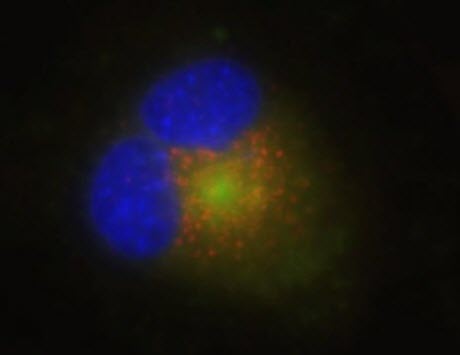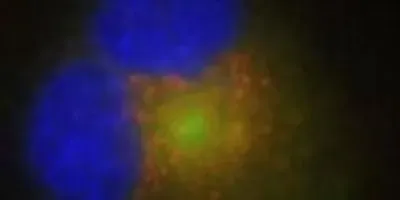 New fluorescent dyes help illuminate lysosome structures.Michigan Technological University“A lot of diseases are related to problems with lysosome functions,” says Jingtuo Zhang, a chemistry doctoral candidate at Michigan Tech. Zhang and his advisor, Haiying Liu, have developed the new probes, essentially chemical dyes that illuminate lysosome structures with fluorescence.
New fluorescent dyes help illuminate lysosome structures.Michigan Technological University“A lot of diseases are related to problems with lysosome functions,” says Jingtuo Zhang, a chemistry doctoral candidate at Michigan Tech. Zhang and his advisor, Haiying Liu, have developed the new probes, essentially chemical dyes that illuminate lysosome structures with fluorescence.
“These kinds of lysosome probes respond to pH, and that gives us a more clear idea of a cell’s health,” Zhang says.
Responding to different acidic conditions within lysosomes is a unique feature of the new probes. This is important because small changes in pH can reflect much bigger problems. Currently, few commercially available lysosome fluorescent probes are sensitive to pH.
Additionally, the fluorescence is near-infrared. That means the probes emit light that can penetrate deeper than commercial dyes, making for better bio-imaging of lysosome structures.
These dyes have minimal toxicity. Much like chemotherapy, imaging lysosomes comes at a cost — the chemicals can be toxic. The team decreased toxicity by creating new molecules, a process called synthesis.
“Designing a molecule is an art, and synthesis is our toolkit,” Zhang explains. He goes on to describe the molecules created by the team using a core of boron dipyrromethene, or BODIPY.
Rings of carbon make up the bulk of BODIPY, like a three-legged stool. The working part of the core is a section with fused carbon rings, nitrogen, boron and fluoride. The BODIPY edges then are modified by piperazine rings. Finally, the team connected long chains. All together, the probe is a leggy molecule centered on the BODIPY rings, trailing flexible carbon chains kinked with oxygens that look like strands of a 1980s Toni Home Perm.
That permed legginess is actually crucial. The oxygen-rich chains make the molecules more water soluble, making it easier on the body and for bio-imaging applications. The piperazine addition then targets lysosome cells specifically, allowing the BODIPY core to do its work in the right place and fluoresce.
In the fluorescent images, the chemicals appear as glowstick-bright colors.
 “There are clear dot structures when we zoom in on the images,” Zhang says, pointing out where the green and red colors have concentrated in the rounded lysosome structures outside the blue nucleus.
“There are clear dot structures when we zoom in on the images,” Zhang says, pointing out where the green and red colors have concentrated in the rounded lysosome structures outside the blue nucleus.
Ideally, he explains, the team wants to see orange, which shows where their probes and popular commercial dyes overlap in the lysosomes. The overlap is good, indicating the probes are indeed targeting the right cellular structure. Ashutosh Tiwari, an assistant professor of chemistry at Michigan Tech, is particularly interested in those orange zones.
 Tiwari worked with Zhang and Liu to apply their synthesized probes and
Tiwari worked with Zhang and Liu to apply their synthesized probes and
oversaw the cell cultures and testing. He says the team is trying to balance the chemical’s impact on the cell without losing its lysosome-targeting and fluorescent
functionality.
“That would be a win-win situation, but in reality it’s really a trade off of certain features,” Tiwari says, adding the low toxicity and near-infrared features are definite wins.
The researchers are currently looking to commercialize their product. They also plan to continue making modifications to the BODIPY fluorescent probes to further enhance the lysosome targeting and lower the toxicity even further.
“A lot of diseases are related to problems with lysosome functions,” says Jingtuo Zhang, a chemistry doctoral candidate at Michigan Tech. Zhang and his advisor, Haiying Liu, have developed the new probes, essentially chemical dyes that illuminate lysosome structures with fluorescence.
“These kinds of lysosome probes respond to pH, and that gives us a more clear idea of a cell’s health,” Zhang says.
Responding to different acidic conditions within lysosomes is a unique feature of the new probes. This is important because small changes in pH can reflect much bigger problems. Currently, few commercially available lysosome fluorescent probes are sensitive to pH.
To continue reading this article, sign up for FREE to

Membership is FREE and provides you with instant access to eNewsletters, digital publications, article archives, and more.














